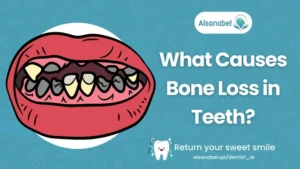
Tooth bone loss is a serious dental concern that can lead to significant complications, including tooth mobility, gum recession, and eventual tooth loss. While many people focus on preventing cavities and gum disease, they may not realize that the bone supporting their teeth is just as critical for long-term oral health. When bone loss in teeth occurs, it weakens the foundation that holds teeth in place, making them more susceptible to damage and eventual extraction.
Understanding the causes of dental bone loss is crucial for taking preventive measures. Additionally, modern dentistry offers various treatment for tooth bone loss solutions to restore and maintain jawbone density. In this article, we will explore the primary causes of tooth bone loss, its effects, and the most effective treatment options available.
What Causes Bone Loss in Teeth?

1. Gum Disease (Periodontitis)
One of the leading causes of dental bone loss is gum disease. Gum disease begins as gingivitis, characterized by inflammation and bleeding gums. If left untreated, it progresses to periodontitis, which can cause:
- The gums to pull away from the teeth, forming deep pockets.
- Bacterial infections to spread below the gumline.
- The destruction of bone and connective tissues supporting the teeth.
Over time, untreated periodontitis weakens the jawbone, resulting in significant bone loss in teeth and, in severe cases, tooth loss.
2. Tooth Loss and Lack of Jawbone Stimulation
Each tooth plays a vital role in maintaining jawbone density. The roots of teeth provide stimulation to the underlying bone, which encourages bone regeneration.
- When a tooth is lost due to decay, trauma, or extraction, the lack of stimulation causes the surrounding bone to shrink over time.
- The longer a tooth remains missing, the more bone loss in teeth occurs, making future restorations more challenging.
3. Osteoporosis and Other Systemic Conditions
Osteoporosis is a disease that reduces bone density throughout the body, including the jawbone. Individuals with osteoporosis are at a higher risk of developing tooth bone loss, particularly in older adults.
Other medical conditions, such as diabetes and autoimmune diseases, can also contribute to bone loss in teeth by affecting the body’s ability to maintain healthy bone structures.
4. Chronic Teeth Grinding (Bruxism)
Bruxism, or excessive teeth grinding and clenching, exerts excessive pressure on the jawbone and supporting tissues. Over time, this constant force can contribute to:
- The gradual breakdown of the bone supporting the teeth.
- Increased risk of fractures and weakened jaw structure.
Many people grind their teeth subconsciously, especially during sleep. Using a custom night guard can help protect the teeth and reduce stress on the jawbone.
5. Poor Oral Hygiene and Plaque Buildup
Neglecting proper oral hygiene can lead to plaque buildup, which harbors bacteria responsible for gum infections and tooth bone loss.
- Failing to brush and floss regularly allows bacteria to thrive and cause inflammation.
- Over time, untreated gum disease erodes both soft and hard tissues, leading to progressive bone loss in teeth.
6. Ill-Fitting Dentures and Bridges
Dentures and bridges that do not fit properly fail to provide adequate support and stimulation to the jawbone.
- Long-term denture use without proper adjustments can accelerate bone shrinkage in areas where natural teeth are missing.
- Over time, this may cause difficulty in fitting future dental prosthetics.
7. Smoking and Poor Lifestyle Choices
Smoking negatively affects overall oral health by:
- Restricting blood flow to the gums and bone tissue.
- Reducing the body’s ability to fight infections, increasing the risk of gum disease.
- Weakening the bone structure, making it more susceptible to bone loss in teeth.
Can Bone Loss in Teeth Be Reversed?
The ability to reverse bone loss in teeth depends on the severity of the condition. While minor bone loss may be slowed or partially restored, advanced bone loss requires intervention.
Ways to Slow or Reverse Bone Loss:
- Bone Grafting: A procedure that helps regenerate lost bone by placing graft material in the affected area.
- Improved Oral Hygiene: Brushing, flossing, and using antibacterial mouthwash prevent further deterioration.
- Diet and Nutrition: Increasing intake of calcium, vitamin D, and magnesium supports bone health.
- Dental Implants: Can stimulate jawbone regeneration and prevent further bone loss.
How Does Gum Disease Lead to Bone Loss?
Gum disease weakens the structures that support the teeth, leading to progressive bone deterioration. Here’s how it happens:
- Bacterial Invasion: Plaque bacteria trigger inflammation, causing gums to recede.
- Pocket Formation: As the gums pull away from the teeth, deep pockets form, trapping bacteria.
- Bone Destruction: The body’s immune response starts breaking down bone and connective tissue.
- Tooth Mobility and Loss: As more bone is lost, teeth become loose and eventually fall out.
Preventing gum disease through proper oral care and professional cleanings is essential to avoiding tooth bone loss.
What Treatments Are Available for Tooth Bone Loss?
The appropriate treatment for tooth bone loss depends on the extent of damage and the patient’s overall oral health. Below are the most effective treatment options:
1. Bone Grafting
Bone grafting is a surgical procedure that rebuilds lost bone by:
- Using bone from another part of the body, a donor, or synthetic materials.
- Encouraging new bone growth in areas affected by bone loss in teeth.
This procedure is often required before placing dental implants in cases of severe bone loss.
2. Guided Tissue Regeneration (GTR)
- A special membrane is placed to stimulate bone regrowth.
- Prevents unwanted tissue from filling in areas where bone should regenerate.
3. Dental Implants
Yes, dental implants are one of the best solutions for preventing further bone loss.
- Implants act as artificial tooth roots, stimulating the jawbone to maintain density.
- Unlike dentures, implants fuse with the bone (osseointegration) and prevent future bone resorption.
4. Scaling and Root Planing
- A deep cleaning procedure to remove plaque and bacteria.
- Reduces inflammation and slows down further bone loss in teeth.
5. Medications and Supplements
- Antibiotics and mouth rinses help control bacterial infections.
- Calcium and vitamin D supplements support overall bone health.
Frequently Asked Questions About Tooth Bone Loss

1. What causes bone loss in teeth?
Bone loss in teeth occurs due to gum disease, missing teeth, osteoporosis, bruxism, and poor oral hygiene.
2. Can bone loss in teeth be reversed?
Minor bone loss may be reversed through bone grafting, better oral hygiene, and dental implants.
3. How does gum disease lead to bone loss?
Gum disease causes bone loss by eroding gum tissue, breaking down connective fibers, and destroying the bone that supports teeth.
4. What treatments are available for tooth bone loss?
The best treatment for tooth bone loss includes bone grafting, dental implants, guided tissue regeneration, and deep cleaning procedures.
5. Can dental implants help with bone loss?
Yes, dental implants prevent further bone loss by stimulating the jawbone and maintaining its density.
Tooth bone loss is a serious issue that requires immediate attention to prevent long-term complications. Understanding the causes of dental bone loss and seeking early treatment can help protect your oral health. Whether through bone grafting, dental implants, or periodontal treatment, modern dentistry offers effective solutions to restore lost bone and strengthen the jaw structure. If you suspect bone loss in teeth, consulting a dentist is crucial for timely intervention and the best possible outcome.
%20(2).jpg)
